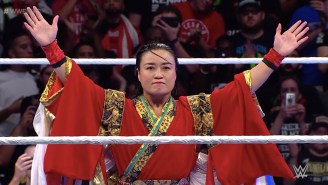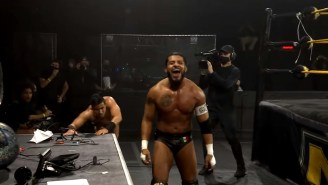New Japan has been the talk of the pro wrestling world in January, between their tremendously well-received Wrestle Kingdom 11 event, the announcement that the company would be holding its first two standalone events in Long Beach this summer, and Kenny Omega doing everything he can to stir the pot regarding his potential impending free agency.
In fact, things are going so well for New Japan that they’re thinking of following WWE’s lead and expanding globally. Their plan of attack to penetrate the North American market is to “establish a territory” in California next year, but that seems like it’s going to be much easier said than done.
This past week, Takaaki Kidani, the owner of New Japan, had an interview with Weekly Pro Wrestling that was translated by Chris Charlton on Twitter. In that interview, Kidani went on at length about the tentative vision he has in mind for establishing a United States territory for New Japan, based in California. It is his goal to “really get going” with this plan in 2018. Here are the key quotes and points from the long interview:
“[A North American New Japan offshoot] would be a localized product. If in Japan it’s 75/25 Japanese, then 75/25 American would be the best mix I think. For the New Japan product we run now, there’s still video. The plan would be to have California as a base and run tours in a similar way to how we run things here, with a few shows further afield.
“For the Japanese talent, there are all sorts of options. Some guys may want to tour there. Some guys may want to spend half the year there. Still others may want to take two years or so and move out there. There are a lot of ways around that and I’m open to opinion from the wrestlers.
“If we establish a territory in California, we’ll be able to produce more content cheaply. It has to be localized. If you look at WWE with their show business base, they really only have a strong business in the U.K., Canada and America. They sell their programming elsewhere, sure, but they need to actually be doing business in those areas. I said this on Twitter, but why do you think they’re pushing people to the network? It’s because they know cable isn’t going to be around forever and they have to make up that loss. That’s why they established a U.K. champion and set up that tournament. [ … ]
“Things start with the G-1 special, which we announced will take place on 7/1 and 7/2. That won’t include any actual tournament matches, but we may hold qualifiers. At that point, office staff will also be headed to the U.S. We will set up a dojo, likely with a monthly fee system. And as far as talent is concerned, from October of last year, we began signing wrestlers to long-term contracts, and this includes foreign wrestlers. [ … ]
“I have talked with the talent about this, but at that point it was less concrete than it is now. The plan is for thing to really get going in 2018.”
In the latest Wrestling Observer Newsletter, Dave Meltzer addressed pretty much all of Kidani’s comments, essentially point by point. You will need a subscription, but if you have one and have the time, it’s worth taking the time to read what Meltzer has to say. Essentially, taking Kidani’s words entirely at face value, Meltzer warns that Kidani is grossly overestimating New Japan’s popularity and viability in the United States, in addition to demonstrating a fundamental misunderstanding not only of what makes WWE’s business model successful, but also the state of professional wrestling in North America at this point, and the historical lessons to be learned from the collapse of the territory system nearly 30 years ago.
Essentially, New Japan will be spreading its roster very thin by attempting to establish an offshoot in North America, and for U.S. fans, the draw is not the New Japan name, it’s the stars. One thing that Meltzer failed to note was that a Japanese promotion has attempted something similar before with Dragon Gate USA, which ran on its own for a few years, but the company quickly became mostly North American talent, with a few Dragon Gate regulars sprinkled in, and then eventually got folded into EVOLVE shows and storylines before going on indefinite hiatus.
Admittedly, Dragon Gate at the height of its popularity isn’t anywhere near the level of success and word of mouth that New Japan has been experiencing over the past few years, but as Meltzer also pointed out in the Observer, even with the drastically increased interest in Wrestle Kingdom 11, Kenny Omega, and everything else, New Japan in the U.S. remains a starkly hardcore niche. Meltzer reported that heading into the day of Wrestle Kingdom, Google searches never cracked 20,000 people looking for information about the event, which is essentially nothing.
This is all just a long-winded way of saying that New Japan may have lofty hopes, but the deck is fantastically stacked against them. If they hope to establish a California “territory” where they run a handful of “mega-cards” per year in venues with a few thousand seats, at most, they may have some success building good word of mouth and perhaps some lingering brand royalty. If they are legitimately attempting to foster an ongoing, full-time “territory” based in California, with their talent split between the United States and Japan, they will find themselves looking at a steep uphill climb, and might be surprised how limited their fanbase really is in North America.






